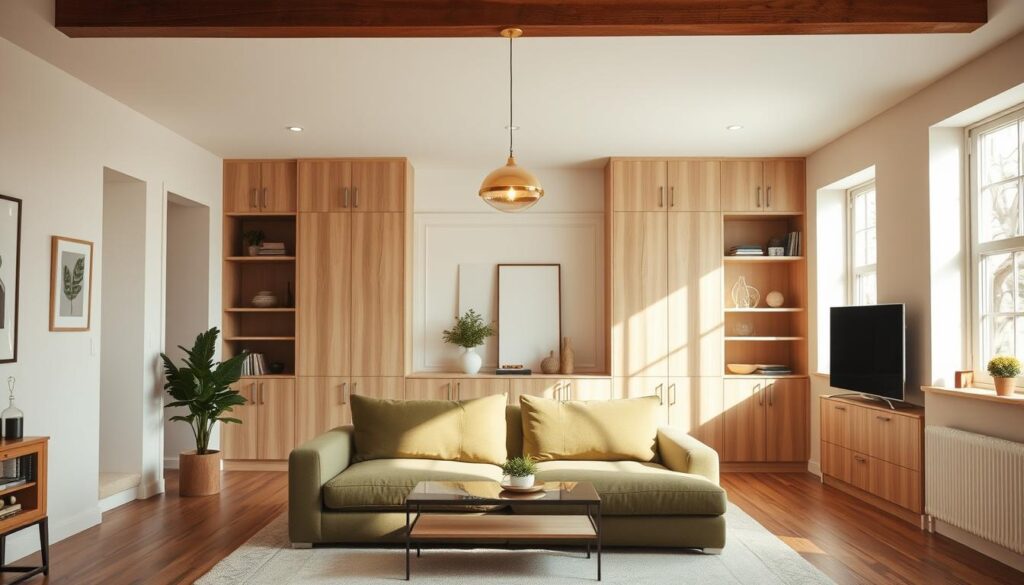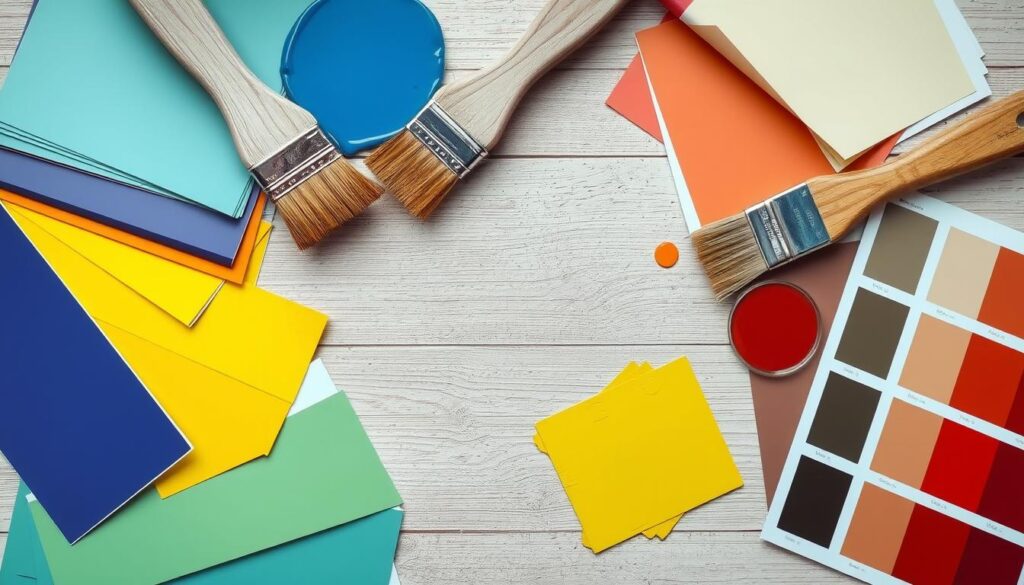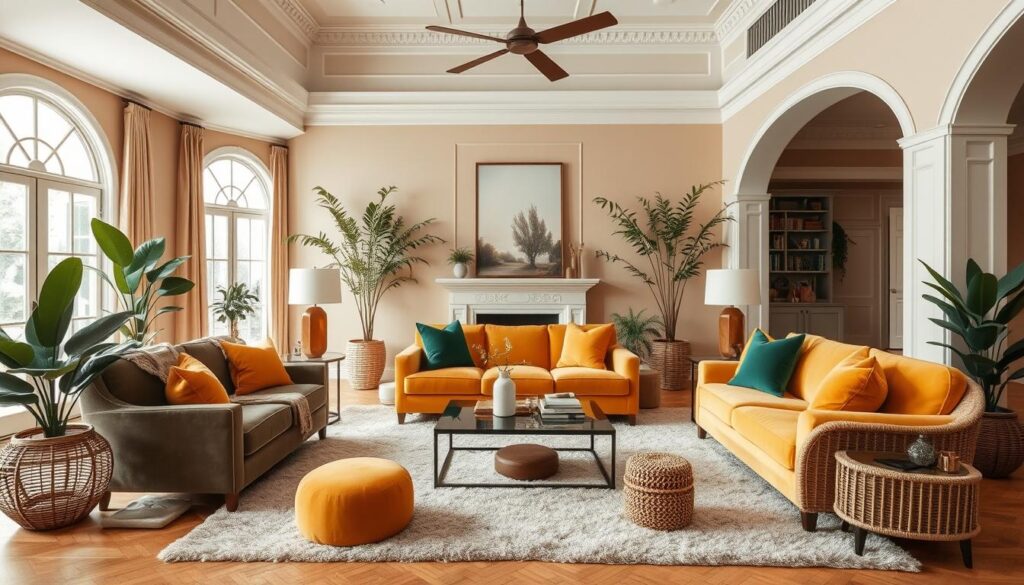Did you know the right color scheme can boost your home’s value by up to 5%? A well-chosen color palette does more than just look good. It shapes the feel and use of your rooms. In this guide, we’ll dive into the world of home interior color combinations. We’ll give you the tools and ideas to change your living areas.
We’ll cover the basics of color theory, the latest trends, and how to mix colors smoothly. Whether you want to update one room or your whole home, our guide is here to assist you. We aim to help you make smart choices.
Key Takeaways
- Understand the principles of color theory to create stunning color combinations.
- Discover current trends in home interior design.
- Learn practical tips for creating harmonious color palettes.
- Make informed decisions when choosing a color scheme for your home.
- Transform your living spaces with our expert guidance.
Understanding Color Theory for Home Interiors
Color theory is key to creating beautiful and useful home interiors. It helps us pick an interior design color palette that looks good and improves our mood and room function.
The Basics of Color Wheel
The color wheel shows how colors are connected. It has primary colors (red, blue, yellow), secondary colors (orange, green, purple), and tertiary colors (mixes of primary and secondary). Knowing the color wheel helps us choose a color palette that works well together.
Complementary Colors Explained
Complementary colors are pairs that are opposite each other on the color wheel. They create a bold contrast and add interest to your design. For example, blue and orange together can make a room lively. But, it’s important to balance these colors to avoid overwhelming the space.
The Psychology of Color in Spaces
The psychology of color affects how we feel in different spaces. Colors can make us feel calm or energized. Cool colors like blue and green can relax us, while warm colors like red and orange can energize us. Choosing the right colors for each room can make our home feel better and work better.
Popular Color Trends for 2023
This year, home interior color trends are changing. Earthy tones, bold hues, and soft pastels are now popular. Refreshing our homes means keeping up with these colors to make them look better.
There are many colors to choose from, fitting different tastes and decor styles. Let’s explore each trend in detail.
Earth Tones: Embracing Nature
Earth tones are becoming more popular. They bring the outdoors inside. Shades like green, terracotta, and beige create a calm, natural feel.
- Terracotta: Adds warmth and coziness to any room.
- Sage Green: Brings a sense of balance and harmony.
- Sandy Beige: Offers a neutral background that complements other colors.
Bold, Vivid Hues for Modern Spaces
For a bold statement, choose vibrant colors. Deep blues, rich emeralds, and bright yellows modernize any room.
Here’s how to use bold colors:
- Use them as accent walls for a focal point.
- Include them in furniture and decor.
- Balance bold colors with neutrals to avoid overwhelming the space.
Soft Pastels: A Gentle Touch
Soft pastels create a calming atmosphere. Shades like pale pink, baby blue, and mint green are great for relaxing spaces.
To use soft pastels well:
- Pair them with neutrals to avoid a too sweet or feminine look.
- Use them sparingly to add softness.
- Try pastel shades for smaller items like throw pillows and vases.
By adding these trendy colors to our decor, we can update our homes. This makes them look fresh and modern, reflecting our style.
Creating a Harmonious Color Palette
Creating a harmonious color palette in your home can seem hard, but it’s doable with the right help. It’s key to pick colors that look good together for a beautiful home. This means choosing colors that complement each other well.
Understanding that a harmonious color palette is more than just picking colors you like is important. The 60-30-10 rule is a helpful guide. It says 60% of the room should be a main color, 30% a secondary color, and 10% an accent color. This rule helps in making a balanced and cohesive look.
Choosing a Dominant Color
Picking a dominant color is the first step. This color will cover the most area, like the walls, and set the room’s mood. For example, calm colors like blues and greens are great for bedrooms. On the other hand, vibrant colors like oranges and yellows can make living areas lively.
“The color palette is the canvas on which you paint your interior design masterpiece. Choosing the right dominant color is like selecting the perfect canvas – it sets the stage for everything else.”
Selecting Accent and Neutral Shades
After picking your dominant color, choose your accent and neutral shades. Accent colors add a burst of color and interest. Neutral shades, like beige, gray, or white, balance the palette. They provide a calm background for your accent colors to stand out.
| Color Type | Description | Example Colors |
|---|---|---|
| Dominant Color | Covers the largest area, sets the tone | Blues, Greens, Neutrals |
| Accent Color | Adds a pop of color, creates interest | Oranges, Yellows, Deep Reds |
| Neutral Shades | Balances the palette, provides calm | Beige, Gray, White |
By carefully picking your dominant color, accent colors, and neutral shades, and using the 60-30-10 rule, you can make a harmonious color palette. The key is balance and cohesion. This ensures all elements work together to make a beautiful and functional space.
Guidelines for Combining Colors
Combining colors is an art that can either make or break a room’s feel. To create a welcoming space, it’s important to follow some key rules.
The Rule of Three in Color Selection
Using the rule of three is a great way to pick colors. You choose three colors that look good together. This includes a main color, a supporting color, and an accent color.
The main color sets the room’s mood. The supporting color helps it out. The accent color adds a fun touch.
For example, in a living room, pick a calming blue as the main color. Use crisp white as the supporting color. Then, add a bright yellow as the accent. This mix makes the room lively and balanced.
Balancing Warm and Cool Tones
It’s also key to balance warm and cool colors. Warm colors like reds and yellows make a room cozy. Cool colors like blues and greens calm it down.
For a balanced look, mix warm and cool tones. For instance, pair a warm beige with cool blue accents. This mix is soothing and balanced, as interior design expert, Jane Smith, once said,
‘The key to a great color combination is finding a balance between warmth and coolness.’
This balance makes a space feel welcoming and comfy.
By following these tips, you can make stylish color pairings that make your home look great. The secret is to experiment and find the right mix that shows off your style.
Using Color in Different Rooms
The colors we pick for our homes greatly affect the mood of each room. Each room has its own purpose, and the right colors can make it better. They can change how we feel in each space.
Kitchens: Invoking Energy and Warmth
Kitchens are the heart of the home, where meals are made and memories are created. To make them lively and warm, choose vibrant yet inviting colors. Warm neutrals like beige and soft reds make the space cozy. Bold colors like yellow and orange can make us hungry and talkative.
- Warm-toned woods and earthy colors add depth.
- Bold colors in accessories like utensils or a statement wall can make a big impact.
Living Rooms: Creating Comfort and Coziness
Living rooms are for relaxing and socializing, so they need to be comfy and cozy. Soft, muted colors help create a calm vibe. Soothing shades like light blue or pale green are great for relaxation. Adding textured elements and neutral tones makes the room even cozier.
- Start with a neutral color for walls and furniture.
- Use throw pillows, rugs, and artwork to add color.
Bedrooms: Cultivating Calm and Relaxation
Bedrooms should be places of rest and calm. Cool, calming colors are best for this. Soft blues and serene greens help create a peaceful space. Stay away from bright, bold colors that might keep you awake.
- Choose soft, muted colors for walls and bedding.
- Keep colors calming and consistent for a relaxing space.
For more ideas on home interior colors, check out our guide at https://oumaatelier.com/discover-the-perfect-home-interior-color-schemes-with-us/. By picking colors wisely for each room, we can make our homes look and feel better.
Color Combinations for Small Spaces
In small spaces, the right colors are key to a beautiful look. The right mix can make a room feel bigger, cozier, or more elegant. We’ll see how light colors can make a room feel airy and how dark shades can add depth.
Light Colors to Enhance Space
Light colors make rooms look bigger. They reflect light, making the space feel open. Soft whites, creams, and pale pastels are great choices. They make the room feel larger and provide a clean look for your decor.
To really make light colors work, use them everywhere. This includes walls, ceiling, and furniture. This creates a smooth look that makes the room feel bigger.
Example Color Palette:
- Soft White (Walls)
- Pale Gray (Furniture)
- Creamsicle (Accent)

Dark Shades for Depth and Sophistication
Dark colors add depth and elegance. They’re perfect for accent walls, furniture, or accessories. Rich jewel tones, deep blues, and charcoal grays are great for adding depth.
To avoid feeling cramped, mix dark shades with light colors. For example, a dark accent wall with light furniture and decor creates a striking contrast. This adds interest without feeling too much.
| Color | Effect | Best Used For |
|---|---|---|
| Soft White | Makes space feel larger | Walls, Ceiling |
| Charcoal Gray | Adds depth | Accent Walls, Furniture |
| Pale Pastel | Creates a fresh look | Accent Pieces, Decor |
“The right color palette can transform a small space into a haven of comfort and style.”
By mixing light and dark colors, you can create a beautiful color palette. This enhances the beauty of your small space.
The Impact of Light on Color Selection
Colors in your home are not just about the paint. They’re also influenced by the lighting. The type and intensity of light can change how colors look, making it key in choosing colors.
Natural Light vs. Artificial Light
Natural light and artificial light affect colors differently. Natural light is seen as the most accurate because it has a balanced spectrum. But, its intensity and color temperature change throughout the day. On the other hand, artificial light has a consistent color temperature but might not show colors as they really are.
Artificial lighting comes in types like incandescent, fluorescent, and LED. Each has a color temperature in Kelvin (K) that changes how we see colors:
- Warm white light (2700K-3000K) makes colors seem yellow or red.
- Cool white light (3500K-5000K) makes colors seem blue or vibrant.
- Daylight (5000K-6500K) is closest to natural daylight, making colors look more natural.
How to Choose Colors for Dark Rooms
Choosing colors for dark rooms needs careful thought. Here are some tips:
- Use lighter shades to reflect light and make the room seem brighter.
- Choose colors that aren’t too saturated, as they can look darker in low light.
- Think about the color temperature of your artificial lighting and how it will affect your colors.
In dark rooms, balancing the color palette is key to avoid a cave-like feel. Mixing lighter and darker shades adds depth and interest.
Understanding how light affects color helps make your home look great, no matter the lighting. Whether it’s a bright room or a darker space, the right colors can make a big difference.
Seasonal Color Trends to Consider
As the seasons change, so do the color trends that can refresh and revitalize our homes. Using seasonal colors in your decor keeps your space looking current and stylish. We’ll look at the latest trends for spring and autumn, giving you ideas for your home.
Spring Inspirations: Fresh and Bright
Spring is the perfect time to introduce fresh and bright colors into your home. Pastel shades, floral hues, and soft greens create a welcoming and uplifting atmosphere. Use these colors in accent pieces like throw pillows, vases, and wall art.
Autumn Shades: Warmth and Comfort
Autumn brings a cozy warmth to our homes with rich, earthy tones. Shades of orange, red, and yellow evoke comfort and warmth. Use these colors in furniture, rugs, and decorative elements.
| Season | Color Trends | Decor Ideas |
|---|---|---|
| Spring | Pastel shades, floral hues, soft greens | Accent pieces, throw pillows, vases, wall art |
| Autumn | Rich earthy tones, orange, red, yellow | Furniture, rugs, decorative elements |
Changing your color palette with the seasons is fun and creative. By using the latest seasonal color trends, you can keep your space looking fresh and current.
DIY Color Combinations: Making It Yours
With a little creativity, you can make stunning DIY color combinations that show off your style. Creating your own color palette is fun and rewarding. It lets you make your space truly yours.
Experimenting with Paint Samples
Start by trying out paint samples to find your DIY color combinations. This lets you see how colors look in your home’s light. Paint small swatches on walls and watch them at different times of day.
- Begin with a main color and pick shades that go well with it.
- Use samples to see how colors work together.
- Think about your furniture and decor when picking colors.
For more tips on making a whole home color palette, see our guide on creating a whole home color palette the easy way.
Combining Textures and Patterns
Mixing different textures and patterns can also boost your DIY color combinations. Adding smooth, rough, and soft elements can make your space more interesting.
- Pick a few textures that match your color scheme.
- Combine patterns like stripes, florals, and shapes for a lively look.
- Pair bold patterns with solid colors to keep things balanced.

By trying out paint samples and mixing textures and patterns, you can create a unique color combination. This makes your home truly special.
Utilizing Accessories to Enhance Color
Accessories are key in making your home look better by adding color. They bring depth and personality, making your space stand out.
Throw Pillows and Rugs
Throw pillows and rugs are great for adding color and texture. Throw pillows can make a sofa or chair pop. Rugs help set the room’s color tone.
When picking these items, think about your room’s colors. Choose patterns and colors that match well.
For example, in a neutral living room, bright throw pillows can be a highlight. A bold rug can connect furniture and warm up the floor.
Artwork and Decorative Elements
Artwork and decor can also boost your color scheme. A big art piece can catch your eye and set the room’s color mood. Think about the colors and feel you want in your space.
Decor items like vases and sculptures can bring in new colors or match existing ones. It’s important to balance these with your room’s colors to avoid too much.
Choosing and placing accessories like throw pillows, rugs, and decor thoughtfully can make your color scheme look great. It shows off your personal style.
Color Mistakes to Avoid in Interior Design
A well-designed home starts with a good color scheme. It’s important to avoid common errors. While trying new colors is fun, some mistakes can make your home look bad.
Overusing Bold Colors
One big mistake is using too many bold colors. A bold color can make a room lively, but too much is too much. Use bold colors as highlights, not the main theme.
For example, a bright red wall works well with neutral furniture and decor. This balance keeps the room from feeling too busy.
Another way to use bold colors is to limit them to specific items. Try bold colors on throw pillows, rugs, or a standout piece of furniture. This way, you can add color without overwhelming the space.
Ignoring the Flow of Color Throughout the Home
Ignoring the flow of color is another mistake. When rooms clash in color, it messes up your home’s look. Choose a color scheme that works for the whole house, with slight changes for each room.
For example, use a neutral base color and change the accent colors for each room. This way, each room has its own feel but still looks connected.
By avoiding these common color mistakes, you can make your home look beautiful and reflect your style.
Conclusion: Finding Your Unique Style
As we wrap up our guide to stunning home interior color combinations, remember that finding your unique style is a personal journey. It’s about trying out colors that show who you are and what you like.
Personalizing Your Space
Choosing colors that speak to you is crucial for making your house feel like home. By picking colors that you love, you create a space that’s truly yours. Whether it’s a bold statement or a calming palette, your color choices should mirror your lifestyle and tastes.
Embracing the Process
Being open to new color combinations can lead to exciting and beautiful results. Don’t hesitate to try different shades and see how they change your space. With each try, you’ll move closer to finding the perfect colors that make your home special.
By focusing on your personal style and embracing the journey of discovery, you’ll find a color scheme that looks great and feels like you.


